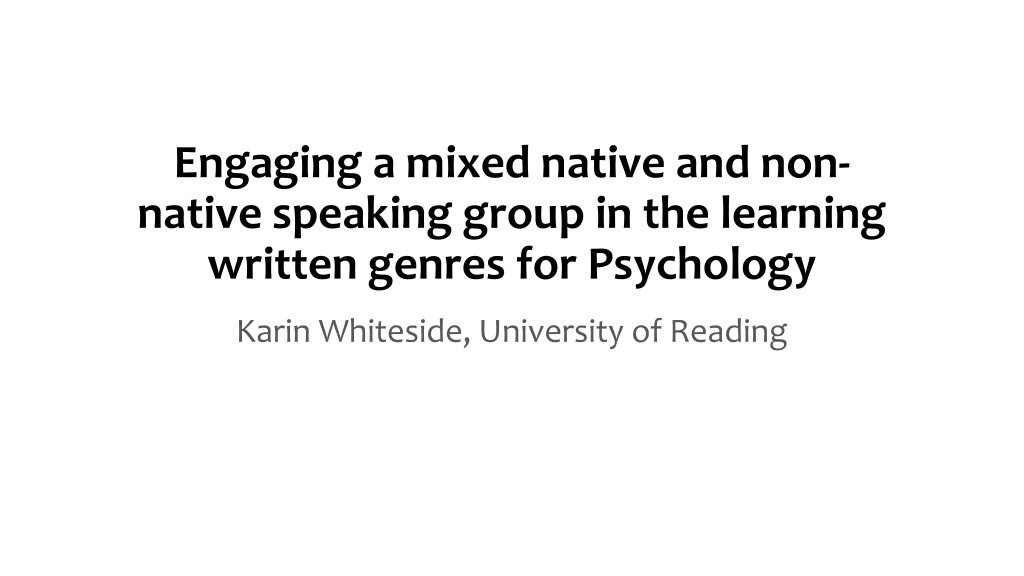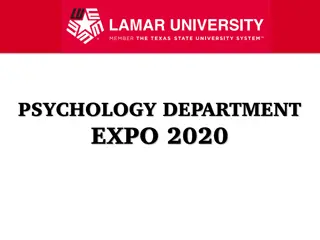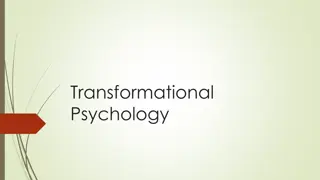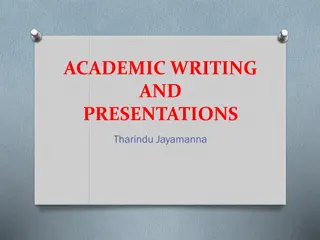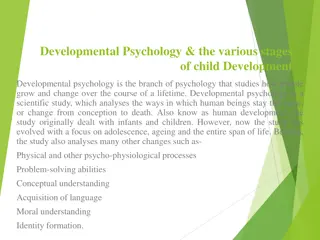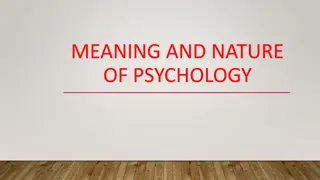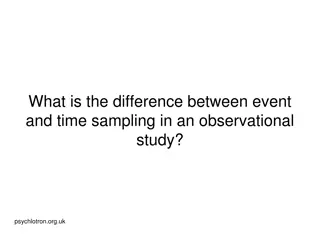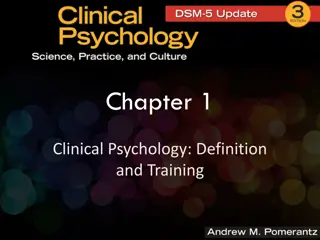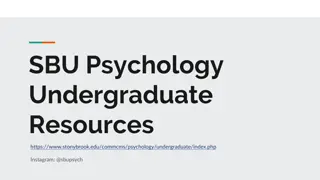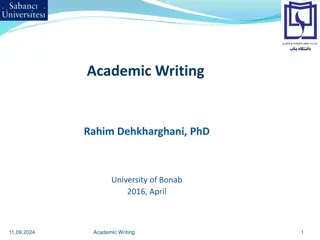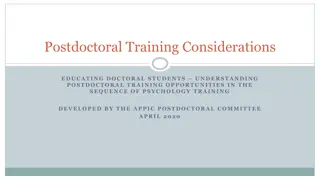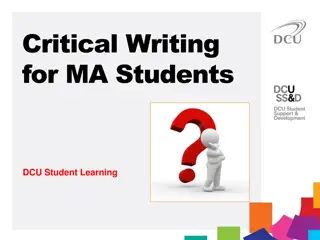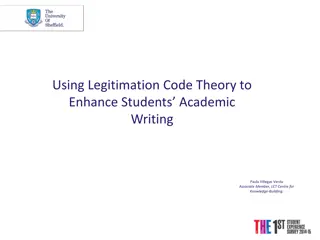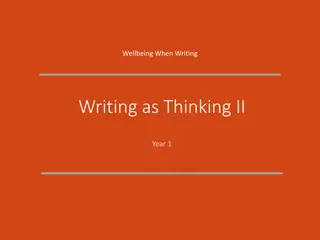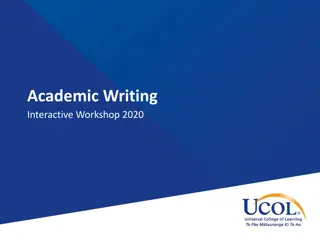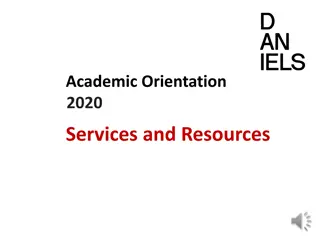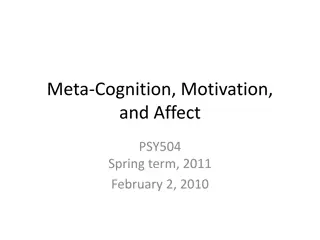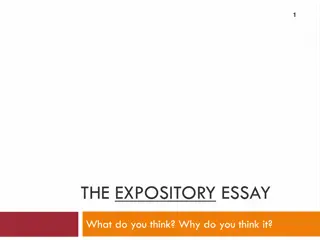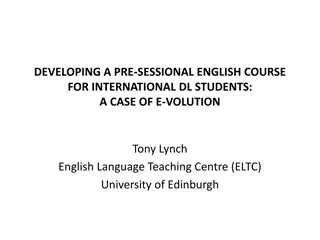Enhancing Academic Writing Skills for Psychology Students
Explore strategies for engaging a mixed group of native and non-native speakers in learning written genres for Psychology, focusing on practical reports, critical reviews, essays, and reflective writing. Understand the importance of discourses as tools in conveying content, meaning, and purpose in academic writing. Learn the process of crafting an argumentative essay effectively, including selecting information, establishing a stance, evaluating evidence, and structuring arguments logically. Practice source use and argument construction by ranking different essay versions on the topic of animals and culture.
Download Presentation

Please find below an Image/Link to download the presentation.
The content on the website is provided AS IS for your information and personal use only. It may not be sold, licensed, or shared on other websites without obtaining consent from the author. Download presentation by click this link. If you encounter any issues during the download, it is possible that the publisher has removed the file from their server.
E N D
Presentation Transcript
Engaging a mixed native and non- native speaking group in the learning written genres for Psychology Karin Whiteside, University of Reading
Background PY1SK <-> PY1SKE 30 (nns & ns) from 150+ first year students An extra assignment Workshops in autumn: Practical Reports & Critical Reviews Workshops in spring: Essays & Reflective Writing
Discourses are tools they do things. That is why they have evolved and thus their functionality determines their character (Martin, 1993, p221) Content & meaning purpose Moves /Stages language Discourse/language features
The process of writing an argumentative essay Select and use information from sources Establish your stance Present your stance coherently Identify relevant sources Evaluate which evidence/ideas can be used Evaluate how evidence/ideas can be used Compare & contrast evidence/ideas from sources Find support for your stance Find rebuttals to counter-arguments State your position clearly Build your arguments logically Guide & involve the reader Write in an appropriate style Reference your sources
Task: Source Use & Argument Read the three VersionsA, B & C, in your Tasks document for this lecture (pp1-2). Each contains two equivalent short extracts from an essay answering the question In what sense can we speak of animals having culture? Rank them in order from strongest to weakest for an essay
Version C is the best: in-depth engagement with the sources sources used as evidence to make arguments linked to the essay question
In Version A: no evidence of writer voice or argument sources have been used heavily and in too much detail without any interpretation by the essay- writer
In Version B: attempt to make an argument in relation to the essay question, but sources used very superficially vague, general statements weak re: progression between ideas and sentences (incl. repetition) ideas from sources have not been adequately explained within the text
one specific aspect of culture expressed with precision vague/imprecise statement about culture Version B Version C A simple form of social interaction is when species learn via patterns of behaviour and therefore exhibit culture (Byrne et al, 2004). White et al (2000) present an example of patterns of mate behaviour which are transmitted from one female quail to another. A focal female is exposed to two types of males with a test female watching, after viewing the mating the test female has to choose a mate for herself. Results showed the test female was more likely to copy the mating preferences of the focal female, suggesting that females make the same choices they have seen others make, and so show patterns of social learning behaviour. It could be said that we can speak of animals having culture at what appears to be a low level of cognitive ability. Human actions are influenced by social context and this is culture, and it can be seen that animals are influenced in the same way so they also have culture. The study by White et al (2000) shows in mating that females make the same choices as others have made, and so learn what to do from the society they are in. The female quail copies other female quails when it comes to mating. Therefore it can be argued animals do have a culture because they are influenced by what other animals in their species do. This can be compared to human behaviour as they are culturally influenced by each other. a clear link lacking necessary detail adequate relevant detail interpretation repetition rather than development mini paragraph-level answer to the essay question vague/simplistic
specific, precise too vague/broad Version B Version C Numerous studies by psychologists have investigated whether animals have a culture or not. Whiten, (2005) and Boesch et al (1998) note that three different groups of Chimpanzees in three different places have different ways of eating ants. This is a cultural difference. Whiten (2005) states that to prove this conclusively would require removing Tai chimpanzees to Gombe to see if their habits changed or stayed the same. However, this is unlikely to be possible because moving chimpanzees from one place to another for an experiment would be unethical. The chimpanzees could feel stress due to the move. This psychological suffering cannot be justified to extend psychological knowledge. Whiten (2005) and Boesch et al (1998) noted that ant catching techniques used by Tai forest chimpanzees differ from chimpanzees that live at Gombe. Both ants and sticks are available at each site, yet Tai chimpanzees use a short stick to pick up just a few ants, whereas chimpanzees in Gombe swipe their hands along a longer stick to collect a large ball of ants. At Mahale where sticks and ants are both still available, chimpanzees do not ever eat ants. The varying degrees of behaviour appear to show different cultural traditions within the same type of environment, and so show culture within a species. However, Whiten (2005) states that to prove this conclusively would require removing Tai chimpanzees to Gombe and vice versa to see if the behaviour continued in the new environment, as it should do if both habitats are the same - the ethical implications of this mean it is unlikely to occur. more detail needed adequate relevant detail Why? How? Explain! clear interpretation & link to essay question too much detail, not relevant to Q caveat (acknowledging limitation of this argument)
Task 2: can you identify three different types of Psychology question in the examples below? Why are some children more popular than others and what consequences does this have for psychological development? 'Evolutionary psychology provides a single unifying starting point for understanding why we think as we do today.' Archer (2001). Discuss. How Strong is the Evidence that Animals Understand Words and Signs in the Same Way that Humans Do? In What Sense can we speak of Animals Having Culture? What factors influence the accuracy of eyewitness testimonies and how can their effects be explained? Is face processing a special perceptual process that is present from birth? How can we improve our treatment of depression with neuroimaging studies? Which early infant abilities and preferences might facilitate later language development? What negative consequences may occur when communicating risk information in the real-world and how can insights from cognitive psychology help?
critical evaluation of evidence Critical discussion 'Evolutionary psychology provides a single unifying starting point for understanding why we think as we do today.' Archer (2001). Discuss. How Strong is the Evidence that Animals Understand Words and Signs in the Same Way that Humans Do? In what sense can we speak of Animals Having Culture? Is face processing a special perceptual process that is present from birth? critical evaluation of possible reasons & implications Cause-Effect Why are some children more popular than others and what consequences does this have for psychological development? What factors influence the accuracy of eyewitness testimonies and how can their effects be explained? Which early infant abilities and preferences might facilitate later language development? Problem-Solution-Evaluation critical What negative consequences may occur when communicating risk information in the real-world and how can insights from cognitive psychology help? How can we improve our treatment of depression with neuroimaging studies? evaluation of the efficacy of solutions
Task: Different types of argumentation (a) Read the two essay extracts How does the argumentation differ? How does this relate to differences in essay type? (a) Re-read the extracts: which sentences contain facts /description?; which sentences contain arguments/interpretations?
argument evidence interpretation
more to and fro in Extract 2 creating the sense of a debate
Guiding the reader Voice Arguing & positioning; engaging with the reader
N.B. As a UG student, mostly avoid I !
caution certainty certainty certainty caution
caution caution caution addressing/involvingthe reader attitude/evaluation attitude/evaluation attitude/evaluation
References Extracts from BAWE (The British Academic Written English (BAWE) corpus [http://www.coventry.ac.uk/research/research-directories/current- projects/2015/british-academic-written-english-corpus-bawe/]) Psychology texts were accessed from Flax [http://flax.nzdl.org/greenstone3/flax] Hyland, K. (2005) Stance and engagement: a model of interaction in academic discourse , Discourse Studies, 7(2), pp. 173-192. Wingate, U. (2012) Argument! Helping students understand what essay writing is about , Journal of English for Academic Purposes 11, pp. 145-154.
